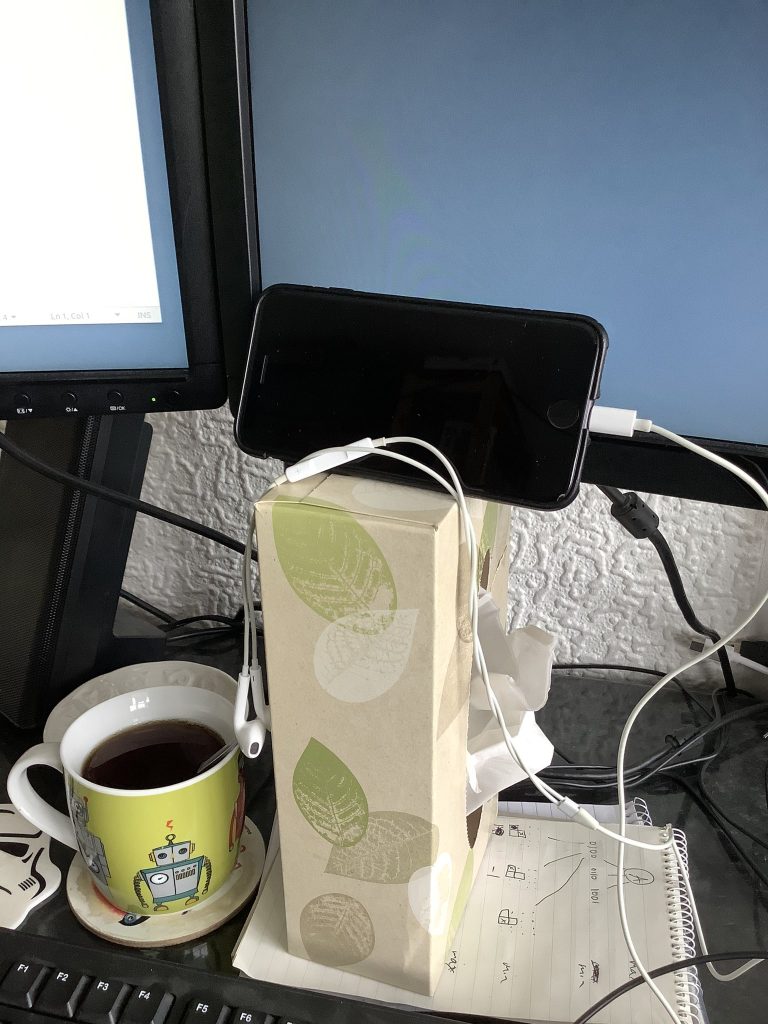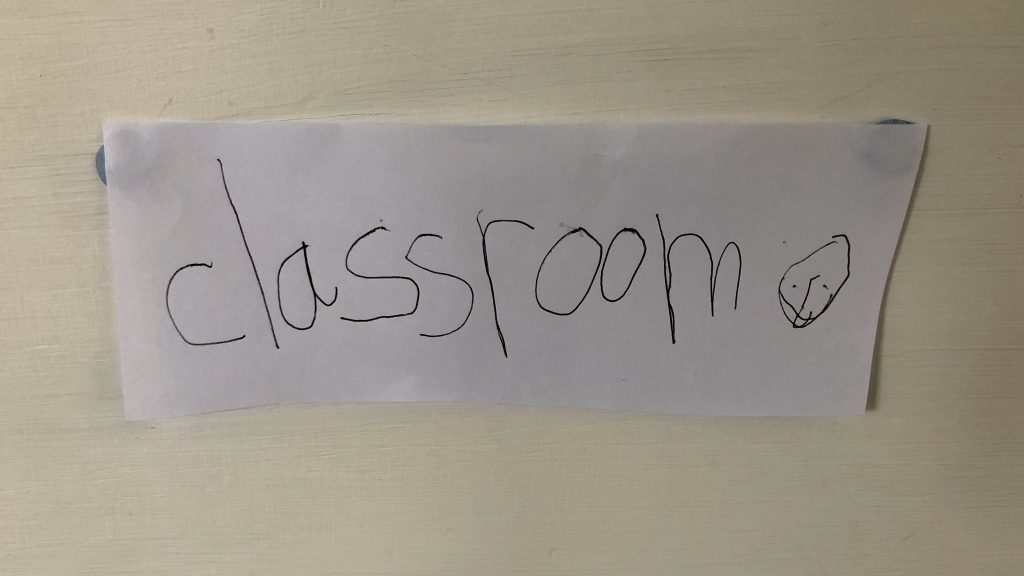I teach maths at university. Last week, I moved to online delivery, in something of a panic. I am writing to share something of how this went.
We were on strike the week before last, a lifetime ago. On the last day, Friday 13th March 2020, picketing was stopped by the union branch in line with the new concept of ‘social distancing’. All day, we waited for news about whether we would be going physically to work on Monday. We watched other universities announce moves to online teaching, not a surprise because contacts and collaborators in other countries have been doing the same recently.
Finally, on Sunday afternoon, work announced there would be a week of physical teaching with a move to online-only the week after, giving us in theory a week to prepare. Of course, this is a week of normal activity, and the days back from strike are always hectic, but there we go. They also announced that if people want to move their teaching online earlier, they could – with permission.
Having seen a lot of advice online from credible sources saying we should be avoiding gathering people together, with a long commute by public transport, and concerned about bringing the virus home to my wife (who has health complications), I sought permission to move my teaching online immediately. Permission was granted, and I stayed home.
I immediately emailed my 1pm class and told them it wouldn’t be running, and I would be in touch. Then I spent the day in wall-to-wall panic mode. I went through each of my modules looking at what is coming up and what can be done about it. I contacted students on each module as soon as I had something to say, made a plan, took any immediate action and wrote a to do list for each module. As well as dealing with an influx of emails, this took up a long day’s work.
There were three more weeks of teaching, a two week Easter break, then one more week of teaching, after which the exam period starts. So four weeks of teaching to worry about, and best not to think about exams at this point. I’m currently teaching on four modules.
One problem with this happening so fast is there wasn’t a lot of time to think about it. I did decide on a few principles, though. I have seen a lot of advice offered by well-meaning people, online and within my institution. Frankly, I didn’t have time to read it. Also, those bits I looked at were fairly overwhelming. There is a massive difference between carefully planning and delivering an online course, and moving to online delivery at speed. For example, I had no time to plan how to deliver courses and I only had the equipment I happened to have at home. Our students didn’t sign up to take an online course, and may not have what they need. There are massive problems here which should not be underestimated. Students may not even have their own computer to work on, might not have a robust internet connection or enough bandwidth to stream a lot of content. They might not have a comfortable place to work at the right time of day. I decided I would keep it simple and try to generate small files where possible. Later in the week, when news started coming in about students maxing out their bandwidth caps and not being able to join live online sessions because systems were overloaded, I was pleased to have made these decisions.
First year mathematical modelling. Of the four remaining sessions, I was due to lead on one of them, an introduction to modelling using ODEs, and I had just agreed to produce an online alternative. Other than helping run sessions that now weren’t going to run, my involvement on the module is marking work already submitted or to be submitted online anyway. The urgent task was to produce something to replace today’s missed session.
Second year programming. Following a term and a half of instruction on various programming topics, my students are working on in-depth, student-directed, individual projects. In some ways, this is straightforward to move online. There is no more direct delivery, my role is supporting students as they direct their work. Hand-in is online. There is a big problem, though: students without machines to work on cannot do programming. The extent of this problem was unknown. I sent an email asking students to get on with their work and, by the end of the week, to email me with an update on their projects. I also asked them to get in touch if they didn’t have access to a machine on which to do the work (though this was also being explored by others in the maths group via other means). I didn’t plan any online videos or whole-class sessions. I said the first port of call if they need support is to email me, and I expected to spend a lot of the time set aside for preparing and delivering classes answering email instead. I said if they had a complicated query or just wanted to talk, we could arrange a time to chat, either via text, audio or audio/video. The urgent task was making some notes on getting Python running on your own machine.
Game Theory and Recreational Mathematics. A colleague was due to deliver a session this week, and said he would prepare something online. After this, we spend two weeks reviewing some combinatorics, graph theory and game theory content from the first semester which will be on the exam, then a week getting to grips with the expectations of the ‘unseen problems’ section of the exam. I emailed the students to ask whether they would like us to run live, whole-class sessions for the last three weeks, or whether they would prefer we write a self-learn package for them to work from. They overwhelmingly chose the latter. This makes perfect sense to me. The idea that they can all find somewhere to work and a decent internet connection at the same time, and are willing to spend their bandwidth limit on this, seems unrealistic. So we’re going to work on a package of revision materials for them to do in their own time.
Final year mathematical modelling. This one is tricky. The module comes in three sections of work run by different people. For the last eight weeks of term, I am delivering a piece of work around data analysis to half the cohort, while the other half are taking a piece delivered by a colleague on cellular automata. We delivered one week, then missed three weekly sessions due to the industrial action, then this is the fifth week. One big problem is that both pieces of work are quite tech-heavy. We discussed this as a module team and decided it was best to abandon the planned work and prepare an alternative for all students. We decided to produce something tech-free, designed for self-learning with distant support. So this is the urgent job in that module.
I had a chat with the person delivering the cellular automata section of the module via my impromptu video conferencing suite.

Final year project. I am supervising five students who are finishing their work and writing up their reports. I emailed them and suggested we meet via video chat, which I did with two of them later in the week. It was nice to catch up and see that they are coping with the ‘new normal’ well, and to have detailed mathematical (or maths history) chat, which seemed quite normal compared with everything else that’s happening.
With action taken, students contacted and plans made, I collapsed at the end of Monday. After-hours, followed updated and quite different Government advice, the university announced an immediate move to online teaching and working from home. This made Tuesday even more chaotic, because suddenly everyone was accelerating plans. I spent the day preparing an online equivalent of the session missed on Tuesday.
I started by setting up some rough-and-ready solutions for preparing the content I needed. I have a touch-screen tablet, but the stylus is in my office. I have a printer/scanner at home though, so I knew I could print, write, and scan back in.

I wrote enhanced versions of my notes, and made a couple of short videos to supplement these. I really see no point in getting everyone to look at a video of my talking at length, this is just creating barriers for students with poor connections, and asking them to spend any bandwidth limit on watching me when they may have much better things to spend it on. I made videos by propping my phone on a pile of books. Hardly perfect, but it worked!

It took several hours, most of Tuesday to prepare this. Much longer than preparing and delivering the physical session would have, and the physical session was already prepared and is printed and sat on my desk!
The rest of the week was a combination of fire-fighting and trying to advance plans for each module. The amount of email has increased substantially, and my triage policy for this has been to prioritise student queries. We set up a work Slack for staff in the maths group, which has been very helpful in reducing email within the group, and offering human contact and support. Of course, there is more to an academic’s work than teaching, and I was able to attend an IMA meeting always planned as a conference call on Wednesday, though it took 15 minutes for everyone to join the call because systems were overloaded. As time goes on and the panic subsides, I need to get to grips with doing the other parts of my job in this new mode of working.
I’m lucky that I had some useful kit at home, and I’m used to working from home so have a little office set up. I’m lucky it happened at a point in the year where modules are coming to an end, with some involving self-directed project work. I’m lucky I can deliver what I need to without getting papers and things from my office. We have a year tutor system, with each year group being looked after by an individual member of staff. It’s good these people were sending supportive messages and guidance to students. We collected some information in one place for students on what they should be doing for each module, because we realise students will be overwhelmed with information just like we are. Our maths group are doing a wonderful job of supporting each other and our students, under the circumstances, and I feel very lucky to be part of it.
On Friday, the Government announced schools would close, so from today my house is acting as both a university and a school. We’ll see what challenge arrives next!

When my school in the US got the lock down orders, they shut classes for a week to give the instructors time to prepare for the shift to online. I was already in an online course, so we didn’t have to shut down, but they knew that trying to shift everyone on the fly was a disastrous idea, so they bought themselves a small window to make the shift.